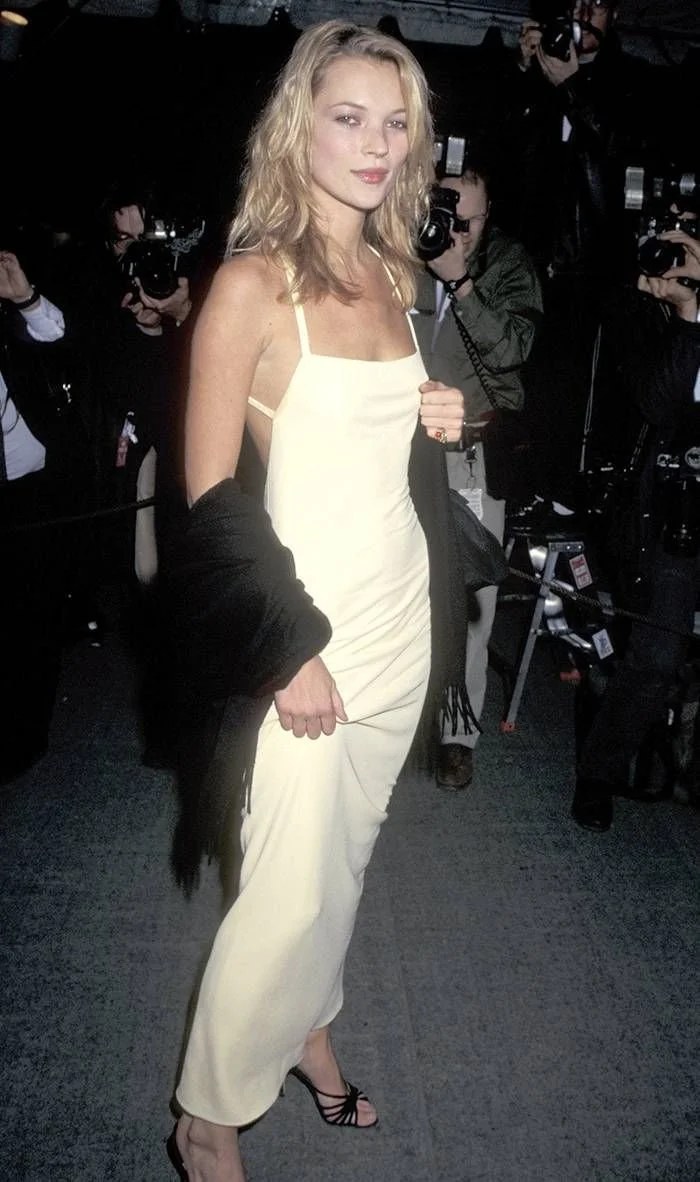Little Miss Moss
Kate Moss was born on January 16, 1974, in Croydon, Greater London, to Linda Rosina Moss, a barmaid, and Peter Edward Moss, an airline employee. Raised in Addiscombe and Sanderstead, she attended Ridgeway Primary School and later Riddlesdown High School. Her life changed dramatically at the age of 14 when she was discovered by Sarah Doukas, founder of Storm Management, at JFK Airport. This chance encounter set the stage for one of the most iconic modeling careers of all time.
Moss’s rise to fame in the early 1990s came as a stark contrast to the prevailing supermodel aesthetic of the time, dominated by figures like Cindy Crawford and Naomi Campbell. She became the face of the ‘heroin chic’ movement—characterized by a waifish frame, pale skin, and dark circles—most notably in her Calvin Klein campaigns. The aesthetic, though influential, was met with criticism, including comments from then-President Bill Clinton. However, Moss defended her appearance as a natural departure from the curvaceous standards of previous models.
Moss’s career hit a major roadblock in 2005 when tabloids published images of her allegedly using cocaine. The scandal led to her being dropped by high-profile brands such as H&M, Burberry, and Chanel. However, her influence in the fashion world remained undeniable. Designers like Alexander McQueen publicly supported her, and within a year, she had signed multiple new contracts, proving her resilience and enduring appeal in the industry. By 2006, she was fully reinstated as one of the most sought-after models.
Beyond modeling, Moss expanded her career into design and business. She collaborated with Topshop to create her own fashion line, launched a fragrance collection with Coty, and worked with brands like Longchamp. She has graced the covers of numerous fashion magazines, including over 30 appearances on British Vogue. Her impact on the fashion world extended beyond modeling as she became a fashion editor for British Vogue and eventually founded her own talent agency, Kate Moss Agency (KMA), in 2016.
Moss’s influence has transcended fashion, inspiring artists and musicians alike. A £1.5 million, 18-carat gold statue of her, titled Siren, was created by sculptor Marc Quinn and displayed at the British Museum. Lucian Freud painted a nude portrait of Moss while she was pregnant, which later sold for nearly £4 million. She has also been referenced in music, literature, and film, cementing her place as a cultural icon.
Moss’s personal life has often been under media scrutiny. She was in a highly publicized relationship with Johnny Depp in the 1990s and later dated musician Pete Doherty. In 2011, she married Jamie Hince, the guitarist of The Kills, but the two divorced in 2016. She is currently in a relationship with Count Nikolai von Bismarck. She has a daughter, Lila Moss, who has followed in her footsteps as a model.
Despite her rebellious image, Moss has contributed to various charitable causes, including War Child, Cancer Research UK, and the Elton John AIDS Foundation. She also designed a Paddington Bear statue for an NSPCC charity auction. Her influence in philanthropy showcases a different side of her—a woman aware of her influence and eager to use it for good.
Kate Moss has continuously reinvented herself throughout her career, surviving scandals and evolving with the ever-changing tides of fashion. Rising to fame in the early '90s as the face of the controversial ‘heroin chic’ aesthetic, Moss defied expectations, outlasting trends and critics alike. Where others faded, she adapted—transforming her image time and again with an intuitive sense of style and timing that kept her not just relevant, but iconic.
Today, she is not only a model but also a businesswoman, mentor, and enduring cultural force. With the launch of her eponymous agency, Moss has stepped behind the lens, cultivating the next generation of talent with the same eye that once captivated the world. Her work now reflects a broader vision of beauty and individuality, signaling a shift from muse to mastermind.
Her transition from rebellious ingénue to respected industry leader is a testament to her resilience and remarkable instinct for reinvention. She has turned moments of controversy into stepping stones, controversies into comebacks—crafting a legacy that is as complex as it is captivating.
From a teenage girl discovered in an airport to a global fashion icon, Kate Moss’s life has been a series of defining moments—each one proving that she is more than just a model. She is a symbol of perseverance, transformation, and timeless influence. In a world that constantly demands reinvention, Moss doesn’t just keep up—she sets the pace.


